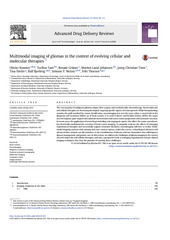Multimodal imaging of gliomas in the context of evolving cellular and molecular therapies
Keunen, Olivier; Taxt, Torfinn; Grüner, Renate; Lund-Johansen, Morten; Tonn, Joerg-Christian; Pavlin, Tina; Bjerkvig, Rolf; Niclou, Simone P.; Thorsen, Frits Alan
Peer reviewed, Journal article
Published version
Permanent lenke
https://hdl.handle.net/1956/9445Utgivelsesdato
2014-09-30Metadata
Vis full innførselSamlinger
Originalversjon
https://doi.org/10.1016/j.addr.2014.07.010Sammendrag
The vastmajority ofmalignant gliomas relapse after surgery and standard radio-chemotherapy. Novelmolecular and cellular therapies are thus being developed, targeting specific aspects of tumor growth.While histopathology remains the gold standard for tumor classification, neuroimaging has over the years taken a central role in the diagnosis and treatment follow up of brain tumors. It is used to detect and localize lesions, define the target area for biopsies, plan surgical and radiation interventions and assess tumor progression and treatment outcome. In recent years the application of novel drugs including anti-angiogenic agents that affect the tumor vasculature, has drastically modulated the outcome of brain tumor imaging. To properly evaluate the effects of emerging experimental therapies and successfully support treatment decisions, neuroimaging will have to evolve. Multimodal imaging systems with existing and new contrast agents, molecular tracers, technological advances and advanced data analysis can all contribute to the establishment of disease relevant biomarkers that will improve diseasemanagement and patient care. In this review,we address the challenges of glioma imaging in the context of novelmolecular and cellular therapies, and take a prospective look at emerging experimental and pre-clinical imaging techniques that bear the promise of meeting these challenges.

